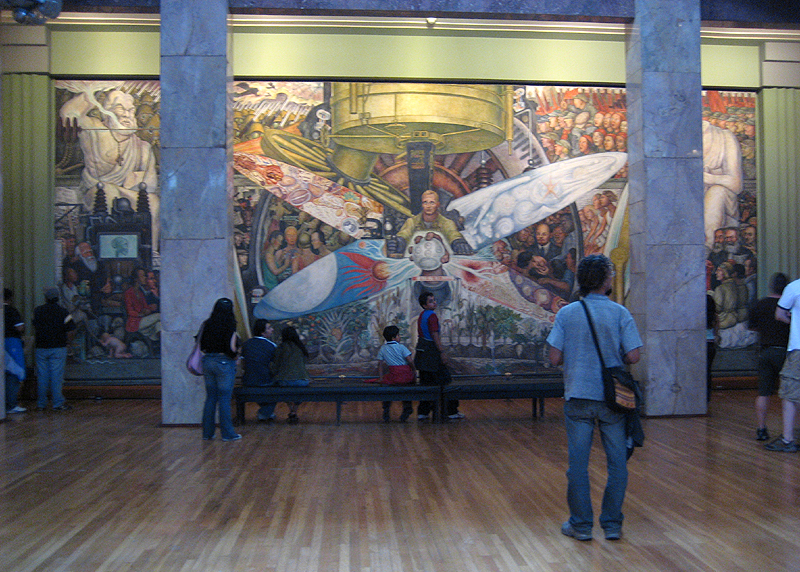
Diego Rivera (31) |
 |
|---|
Source: WTL digital photograph in the Palacio de Bellas Artes, Mexico City. Fresco Triptych: "Man, Controller of the Universe" in the Palacio de Bellas Artes (1934). Mural. Comments: In 1934, the great reformer, Lázaro Cárdenas, is elected President of Mexico (1934-1940). The same year Rivera recreates in revised form the destroyed RCA mural, which you see here as one views it in the magnificent Fine Arts Palace. (For several views of this building, see: => Palacio de Bellas Artes.) Meanwhile, Frida Kahlo separates from her husband and goes to New York City. Behind the two pillars are the three panels of this giant mural. The mural seen here is on the west wall of the third floow of the Palacio. In the center of the central panel is a worker in overalls, symbol of Man, who controls machinery, science, technology. Below the man and the two ellipses are plant forms. The two ellipses in the center, that intersect as if they were two propellers, represent, one, the cosmos, and the other, microscopic organisms. To the man's left (to our right) is the figure of Lenin. To the man's right (our left) is a scene of luxuriating and degenerate (some are syphillitic) rich people. John D. Rockefeller, the patron who commissioned this work from Rivera, is in this scene. Hidden behind the pillar to our right (the man's left) are workers enjoying socialism; while behind the pillar to our left (the man's right) are portraits of Marx, Engels, Trotsky, and Bertram D. Wolfe (Rivera's friend and biographer). Note that Rivera, who at times was a member of the Communist Party, stubbornly refused to eliminate Lenin--the archenemy of capitalism, and, of course, of John D. Rockefeller--from the painting. His refusal created a huge controversy, with massive public demonstrations both in favor of Rivera's leftist stand and against it and in favor of destroying the mural. In the end, Rockefeller cancelled Rivera's commission, paid him the agreed upon fee ($14,000), and destroyed the mural. Rivera's preliminary drawings for the mural, and Lucienne Bloch's secret photographs of the partially completed work, along with many documents by the principals in the controversy, are preserved in Rivera's museum and archives at the Anahuacalli museum in Mexico City. Rivera then proceeded to recreate the mural here in the Palacio de Bellas Artes, as you see it above. Humanities Questions: (A) What do the two intersecting, light-colored ellipses suggest? (B) What do the giant wheels behind the man suggest to you? (One of the ellipses contains elementary biological forms and the other has cosmic forms.) (C) What do you think about the placement of this mural in this building and behind these pillars? Part of the justification for the integrity of the whole mural as seen behind the structural walls in the Palacio de Bellas Artes is that Rivera conceived of the work as a triptych, which, indeed, is what you see, to a certain degree, above. What do you think about this issue? Bibliographical note: For a complete and definitive analysis and exposition about this mural, see the following monumental publication: Man at the Crossroads; Diego Rivera's Mural at Rockefeller Center by Susan Pliego with essays by Javier Aranda Luna and Pablo Ortiz Monasterio. Mexico City: Trilce Ediciones, Museo Diego Rivera, Anahuacalli, 2013. |
|---|
 |